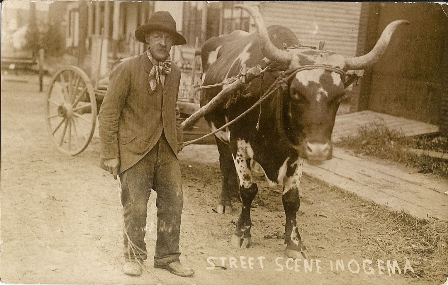|
|
|
|
Ogema 1872 The first settlement in Price County was a railroad station called "Section 89" and later called Corney by the early settlers. It was located on the Little Jump River. In 1872, the railroad commissioned Dennis McGuire to run a boarding camp at the station for the men who were working on building the railroad. This made Mr. McGuire the first settler to the area. Ernest Martin was the next person known to settle here. Mr. Martin was a track foreman for the railroad 1874 The area was similar to the rest of the county, covered in dense forest. But as the area was clear-cut of the timber the land became more suitable for farm lands. In July of 1874, B. M. Holmes was the next settler to arrive. He clear-cut the abundant timber, built a lumber yard, saw mill, store and a home. The next settlers to the area were:
K. A. Ostergren was a Baptist minister who arrived in 1874. He held religious services in Swedish. The Wisconsin Central Railroad appointed him as an emigrant agent in 1878 and then commissioned the Reverend to establish a Swedish settlement near the station stop. Reverend Ostergren's attempts to sway Swedish immigrants to settle here included two trips to Sweden, and trips to both Boston and Rhode Island. 1878 A result of the Reverend's efforts was the arrival of the following folks to the area:
The Wisconsin Central Railroad platted the area in April 1878. In 1875, locals referred to their village as Dedham but by 1876 the name of Ogema had been adopted as the settlement's name. In 1878, several people made suggestions to officially name their new village. One person wanted to name it "Holmes"; another person suggested "Deadham" as that was the name of the next stop on the railroad that was in the process of being abandoned by the railroad. Yet another suggested naming the village "McGuire" after Dennis McGuire who had established the first boarding house for the railroad workers and then the first hotel in 1878. It seemed no one could agree on what to name their new village. One day the old Indian Chief, Chief Ogemageshic, came through the settlement again. The majority of the villagers agreed to name their village Ogema, after him. It was a difficult area to live in and even more difficult for the early settlers to progress with their entrepreneurial endeavors. Supplies came by train because roads in and out of the village were non-existent except for the paths that wound through the woods from one settlement to the another. Despite the remoteness, the first general mercantile store in Ogema was established by A. R. Carlson providing much needed provisions to the village's residents. A second store was built, in 1878, by M. M. Byrnes from Medford. The first school was a small one-room log building. The school's first teacher was Miss Nina Ripley. 1879 The post office was established in 1879 and a Mr. M. J. Burns was the first postmaster. 1880 By 1880 there were about 100 families living in and around the village of Ogema and people continued moving to the area. Buildings were erected and roads began to be built. The first saloon in the village was established by a man named Mackey. He also owned a boarding house. Nels Auly opened a meat market. 1881 In 1881, B. M. Holmes built a boarding house and a row of one-room houses for his mill workers. 1882 Swedish Bethany Lutheran church was built in the spring of 1882 with the Rev. J. julien as the minister. Charles Ohrstrom and Anna Carlson were the first couple married in the church later that year on 24 Dec 1882. The Baptist church was built the same year and the village set aside land for the first cemetery. Prior to that, people were buried on their own property. 1888 By 1888 the population had expanded to over 300 people. Most of the families were Swedish-speaking immigrants enticed to the area by Reverend Ostergren. With the increase in population, it was necessary to establish a secondary school to accommodate all the children. The Ogema High School was thus founded with it's first principle being Julian W. West. 1890 This was one of Ogema's resident's, Emil Boman, walking with his ox in the Village of Ogema around 1890
The Village of Ogema continued to grow and still maintains strong ties to it's past and the courageous and adventurous people who first called it home. Atop Timm's Hill is a monument to the early settlers of Ogema, Spirit and Hill. Please click on photo to open a new page with enlarged image.
An autumn view of Timm's Hill, Sep 2012 If you have information about Ogema that you would like to contribute, please contact the County Coordinator. Still Under Construction
|
You are our 5166 visitor
.
last edited
14 Oct 2012
|
Copyright Notice: All
files on this site are copyrighted by their creator. They may be linked to
but may not be reproduced on another site without specific permission from |



